Ihre WordPress Website versendet keine E-Mails. Eingaben in Kontaktformulare verschwinden, und wichtige Benachrichtigungen kommen nie an. Kommt Ihnen das bekannt vor?
Sie sind nicht allein, und das Problem liegt nicht an WordPress selbst. Es ist die Art und Weise, wie Websites normalerweise die Zustellung von E-Mails handhaben.
Wir haben uns auf WPBeginner mit genau diesem Problem beschäftigt. Deshalb verwenden wir WP Mail SMTP und vertrauen darauf, dass es alle unsere E-Mails in WordPress zustellt. Es verwendet SMTP (den Industriestandard für die zuverlässige Zustellung von E-Mails), um sicherzustellen, dass Ihre E-Mails tatsächlich ihr Ziel erreichen.
In diesem Leitfaden zeigen wir Ihnen genau, was die Ursache für Ihre E-Mail-Probleme ist und wie Sie sie mit SMTP beheben können, damit Sie nie wieder eine wichtige Benachrichtigung verpassen.
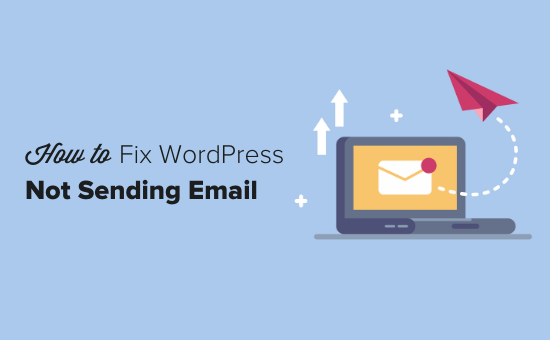
Warum Sie keine E-Mails von Ihrer WordPress-Website erhalten
Der häufigste Grund für fehlende E-Mails ist, dass Ihr WordPress-Hosting-Server nicht richtig für die Verwendung der PHP-Funktion mail() konfiguriert ist.
Auch wenn Ihr Hosting so konfiguriert ist, verwenden viele E-Mail-Dienstanbieter wie Gmail und andere eine Reihe von Tools zur Reduzierung von Spam. Diese Tools versuchen zu erkennen, dass eine E-Mail von dem Ort kommt, von dem sie zu stammen vorgibt.
E-Mails, die von WordPress-Websites verschickt werden, bestehen diesen Test häufig nicht.
Das bedeutet, dass eine E-Mail, die von Ihrer WordPress-Website versendet wird (von einem Kontaktformular-Plugin, einer Admin-Benachrichtigung usw.), möglicherweise nicht einmal im Spam-Ordner des Empfängers landet, geschweige denn im Posteingang.
Aus diesem Grund empfehlen wir, WordPress nicht für den Versand Ihres E-Mail-Newsletters zu verwenden.
Dies ist auch der Grund, warum wir jedem empfehlen, SMTP für den Versand von E-Mails in WordPress zu verwenden.
Was ist SMTP?
SMTP (Simple Mail Transfer Protocol) ist der Industriestandard für den Versand von E-Mails.
Im Gegensatz zur PHP-Funktion mail() verwendet SMTP eine ordnungsgemäße Authentifizierung, was zu einer hohen Zustellbarkeit von E-Mails führt.
WordPress verfügt über ein WP Mail SMTP-Plugin, das Ihre WordPress-Website so konfiguriert, dass E-Mails über SMTP statt über die PHP-Funktion mail() versendet werden.
Sie können es für die Verbindung mit allen gängigen SMTP-Diensten wie SendLayer, Brevo (ehemals Sendinblue), Gmail (Google Workspace), Amazon SES und anderen verwenden.
Sie können unsere WP Mail SMTP Rezension lesen, wenn Sie mehr Details über das Plugin benötigen.
Schauen wir uns also an, wie man das Problem beheben kann, dass WordPress keine E-Mails sendet. Sie können die Links unten verwenden, um durch diesen Artikel zu navigieren:
Alternative: Wenn Sie WooCommerce verwenden und Ihre E-Mails nicht zugestellt werden, dann lesen Sie stattdessen unsere Anleitung zur Behebung des Problems, dass WooCommerce keine E-Mails versendet.
Schritt 1: Installieren Sie das WP Mail SMTP Plugin
Unabhängig davon, für welchen SMTP-Dienst Sie sich entscheiden, müssen Sie das WP Mail SMTP-Plugin auf Ihrer Website installiert haben. Damit können Sie WordPress von der integrierten PHP-Funktion mail() auf Ihren SMTP-Dienst umstellen.
Installieren und aktivieren Sie zunächst das WP Mail SMTP-Plugin. Wenn Sie sich nicht sicher sind, wie das geht, lesen Sie unsere Schritt-für-Schritt-Anleitung für die Installation eines WordPress-Plugins.
Klicken Sie anschließend in Ihrem WordPress-Dashboard auf “WP Mail SMTP”, um die Plugin-Einstellungen zu konfigurieren.
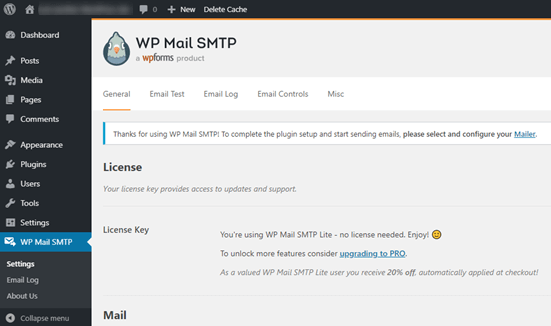
Zunächst müssen Sie den Namen und die geschäftliche E-Mail-Adresse eingeben, von der die E-Mails für Ihre Website kommen sollen.
Achten Sie darauf, dass Sie hier dieselbe E-Mail-Adresse verwenden, die Sie auch für Ihren SMTP-Versanddienst nutzen.
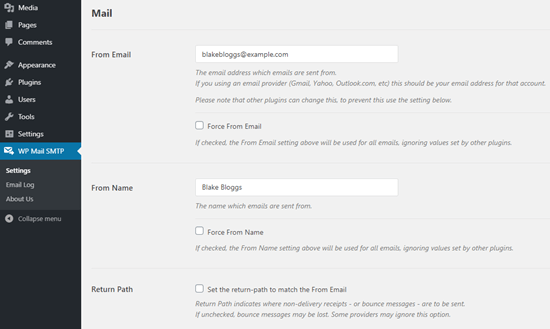
Sie können festlegen, dass E-Mails diesen Namen und diese E-Mail-Adresse verwenden sollen, auch wenn andere Plugins, wie WPForms, andere Einstellungen haben. WP Mail SMTP setzt die Einstellungen der anderen Plugins außer Kraft.
Danach müssen Sie einen SMTP-Versanddienst für Ihre Website auswählen. In diesem Lernprogramm werden wir SMTP mit SendLayer einrichten.
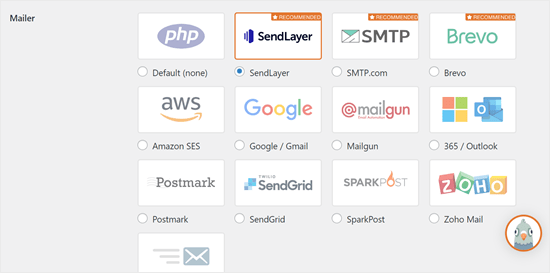
Um die Einrichtung von WP Mail SMTP abzuschließen, müssen Sie ein Konto bei SendLayer erstellen. Wir werden als Nächstes damit fortfahren und dann auf die abschließende Einrichtung von WP Mail SMTP zurückkommen, also stellen Sie sicher, dass Sie diese Registerkarte geöffnet lassen.
Schritt 2: Einrichten Ihres SMTP-Mailingdienstes
SendLayer ist ein zuverlässiger E-Mail-Dienstleister. Damit können Sie eine große Anzahl von E-Mails mit hoher Zustellbarkeit versenden.
Mit SendLayer können Sie kostenlos bis zu 200 E-Mails versenden, was für die meisten kleinen Websites für den Anfang mehr als ausreichend ist.
Dies können E-Mails von Ihrem Kontaktformular, neue Benutzerkontodaten, E-Mails zur Wiederherstellung des Passworts oder andere E-Mails sein, die über Ihre WordPress-Website gesendet werden.
Zuerst müssen Sie auf die SendLayer-Website gehen, um ein Konto zu erstellen. Klicken Sie auf der Preisseite auf den Link “Testen Sie unsere kostenlose SendLayer-Testversion (bis zu 200 E-Mails senden)”, um Ihr Konto einzurichten.
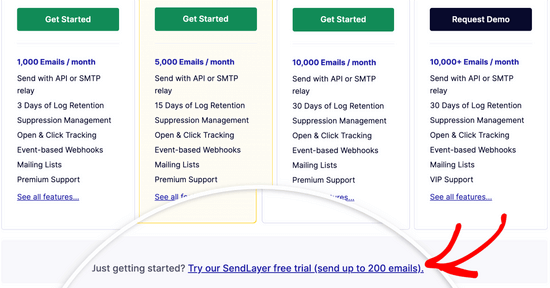
Sobald du ein Konto erstellt hast, siehst du dein SendLayer-Dashboard.
Jetzt, wo Sie ein SendLayer-Konto haben, können Sie Ihren E-Mail-Anbieter mit WordPress einrichten.
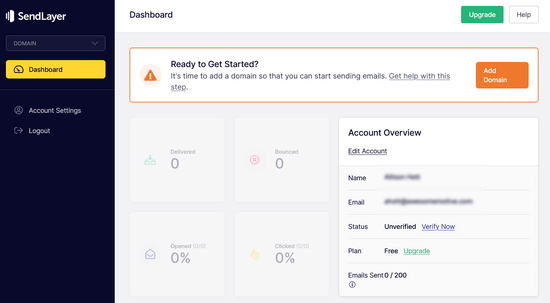
Schritt 3: Verbinden Sie Ihre WordPress-Website mit SendLayer
Bevor Sie E-Mails mit SendLayer versenden können, müssen Sie Ihre Domain autorisieren.
Dies beweist den E-Mail-Servern, dass Sie der bestätigte Inhaber Ihrer Absenderdomäne sind und dass Ihre E-Mails von einer legitimen Quelle gesendet werden.
Um Ihre Domain zu autorisieren, klicken Sie auf die orangefarbene Schaltfläche “Domain hinzufügen” im SendLayer-Dashboard.
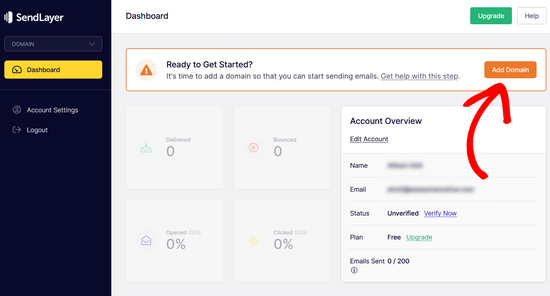
Geben Sie auf der nächsten Seite einfach Ihren Domänennamen in das vorgesehene Feld ein.
Klicken Sie dann auf die Schaltfläche “Domäne hinzufügen”.
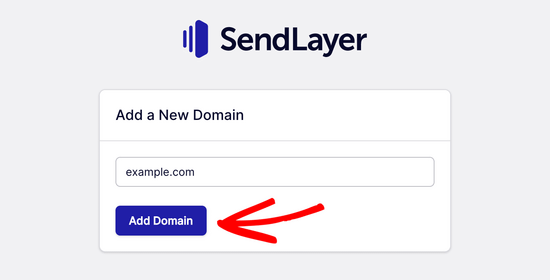
Hinweis: Bei anderen Mailing-Diensten wie Brevo (ehemals Sendinblue) müssen Sie zunächst eine Subdomain für Ihre Website einrichten. SendLayer hingegen fügt die Subdomain automatisch zu den DNS-Einträgen der Absenderdomain hinzu.
Sie müssen also bei der Registrierung der Domäne keine zusätzliche Subdomäne hinzufügen.
Sobald Sie Ihre Domain hinzugefügt haben, zeigt SendLayer Ihnen 5 DNS-Einträge, die Sie zu den DNS-Einstellungen Ihrer Domain hinzufügen müssen.
Mit diesen Codezeilen kann SendLayer Ihren Domainnamen autorisieren.
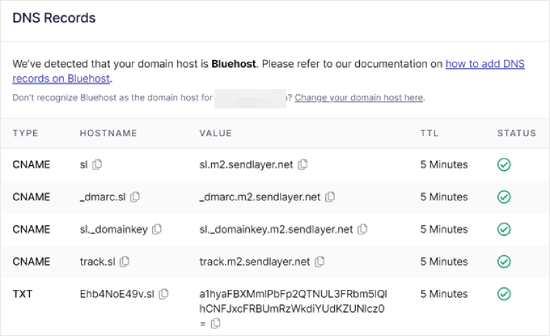
Sie müssen diese DNS-Einträge zu Ihrer WordPress-Website hinzufügen. Das mag kompliziert erscheinen, aber Sie brauchen sie nur zu kopieren und an der richtigen Stelle einzufügen.
In diesem Tutorial werden wir unser Beispiel anhand unseres Hosting-Kontos bei Bluehost demonstrieren.
Wenn Sie andere Hosts nutzen oder wenn Ihr DNS von einem Domain-Registrar wie Domain.com, Network Solutions oder GoDaddy verwaltet wird, befolgen Sie die entsprechenden Anweisungen.
Sie können auch unsere Anleitung lesen, wie Sie WP Mail SMTP bei jedem Host einrichten können.
Öffnen Sie zunächst eine neue Browser-Registerkarte und melden Sie sich bei Ihrem WordPress-Hosting-Konto an. Suchen Sie dann die DNS-Einträge Ihrer Domain.
Bei Bluehost gehen Sie dazu auf “Domains”. Klicken Sie dann auf “Einstellungen” neben der Domain, die Sie mit SendLayer verbinden möchten.
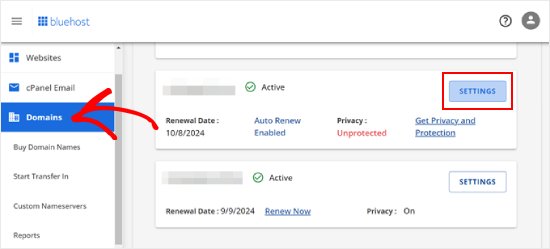
Blättern Sie auf der nächsten Seite nach unten zum Abschnitt “Erweiterte Tools”.
Klicken Sie anschließend auf die Schaltfläche “Verwalten” neben “Erweiterte DNS-Einträge”.
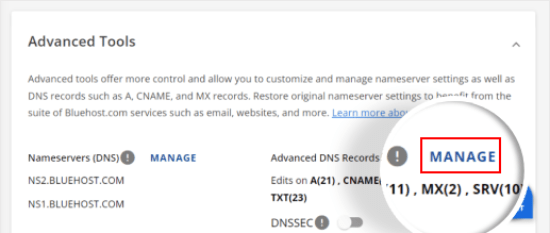
Sie werden eine Warnmeldung sehen, die besagt, dass DNS-Einträge von einem erfahrenen Benutzer bearbeitet werden sollten. Machen Sie sich keine Sorgen wegen dieser Meldung, denn der Vorgang ist ziemlich einfach.
Klicken Sie auf “Weiter”, um fortzufahren.
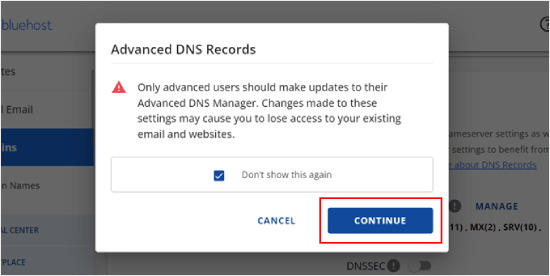
Sie gelangen nun auf die Seite Erweiterte DNS-Einträge verwalten.
Klicken Sie zunächst auf die Schaltfläche “+ Datensatz hinzufügen”.
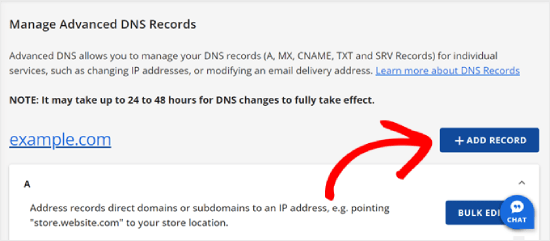
Fügen wir nun die DNS-Einträge hinzu, die SendLayer bereitgestellt hat.
Wählen Sie zunächst den Typ des DNS-Eintrags. In diesem Fall werden wir CNAME für den ersten Eintrag verwenden.
Klicken Sie im Abschnitt “Verweist auf” auf “Anderer Host”. Diese Option werden Sie später für alle Ihre DNS-Einträge wählen.
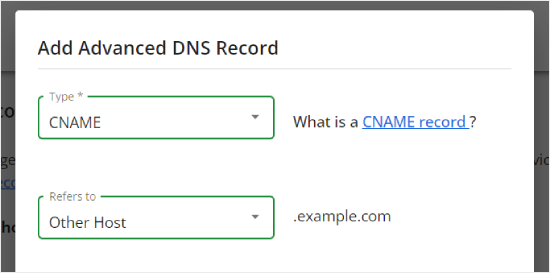
Wenn Sie nach unten blättern, sehen Sie drei Felder: Hostname, Alias und TTL.
Der Hostname sollte mit dem von SendLayer bereitgestellten Wert in ‘Hostname’ ausgefüllt werden. Der Alias sollte mit dem Wert in “Value” ausgefüllt werden. Die TTL können Sie auf 15 Minuten belassen.
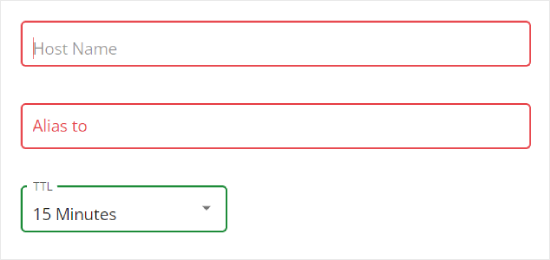
Der folgende Screenshot zeigt, wie unser Bildschirm aussah, als wir unseren ersten CNAME-Eintrag hinzugefügt haben.
Wenn Sie fertig sind, klicken Sie einfach auf “Hinzufügen”.
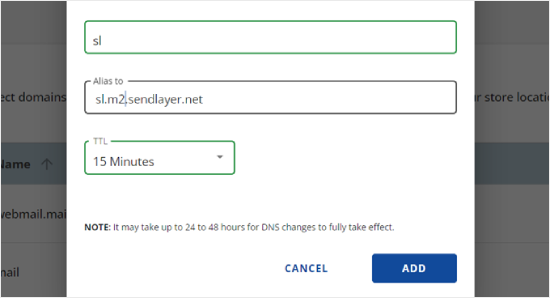
Sie können diese Schritte für alle DNS-Einträge (sowohl CNAME als auch TXT) wiederholen.
Beim Hinzufügen des TXT-Eintrags müssen Sie den Wert “Hostname” aus SendLayer in das Feld “Hostname” und den Wert aus “Value” in das Feld “TXT Value” einfügen.
So sieht es aus:
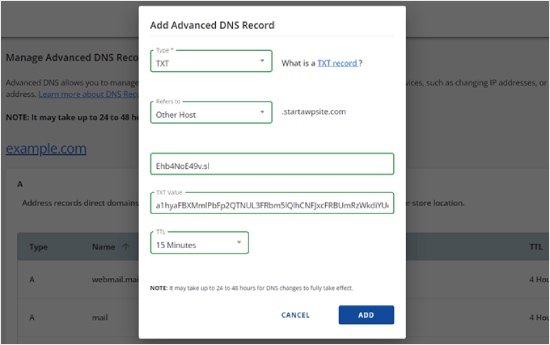
Nachdem Sie Ihre Einträge hinzugefügt haben, kehren Sie zu SendLayer zurück und markieren das Kästchen neben “Ich habe diese DNS-Einträge hinzugefügt und bin bereit, fortzufahren”.
Klicken Sie dann auf die Schaltfläche “DNS-Einträge überprüfen”.
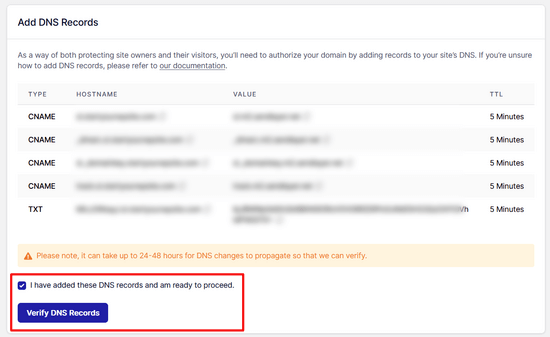
Es kann 24-48 Stunden dauern, bis SendLayer in der Lage ist, Ihre Datensätze zu verifizieren. Nach unserer Erfahrung hat es mehrere Stunden gedauert.
Wenn nichts passiert, wenn Sie auf diese Schaltfläche klicken, können die Einträge noch nicht verifiziert werden. Sie können später noch einmal überprüfen, ob sie verifiziert wurden, indem Sie in Ihrem SendLayer-Dashboard zu “Einstellungen” und zur Registerkarte “DNS-Einträge & Einstellungen” navigieren.
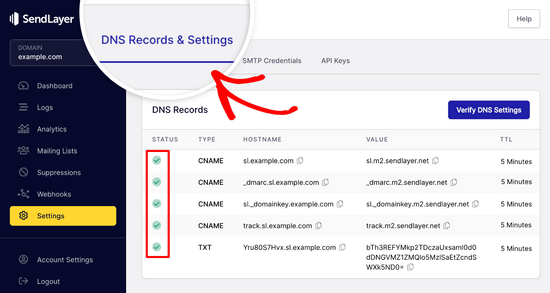
Hier finden Sie eine Liste aller Ihrer DNS-Einträge an einem Ort. Sobald Ihre Domäne erfolgreich autorisiert wurde, sehen Sie grüne Häkchen neben jedem DNS-Eintrag in der Spalte “Status”.
Sie können mit dieser Anleitung weitermachen, während Sie auf die Genehmigung warten.
Schritt 4: Beenden Sie die Einrichtung von WP Mail SMTP zur Verwendung von SendLayer
Lassen Sie uns die Einrichtung abschließen. Gehen Sie zunächst zu Ihrem SendLayer-Konto, um Ihren API-Schlüssel zu finden.
Gehen Sie im SendLayer-Dashboard einfach auf die Seite Einstellungen “ API-Schlüssel. Hier sehen Sie einen Standard-API-Schlüssel, der generiert wurde, als Sie Ihre Domain in SendLayer autorisiert haben.
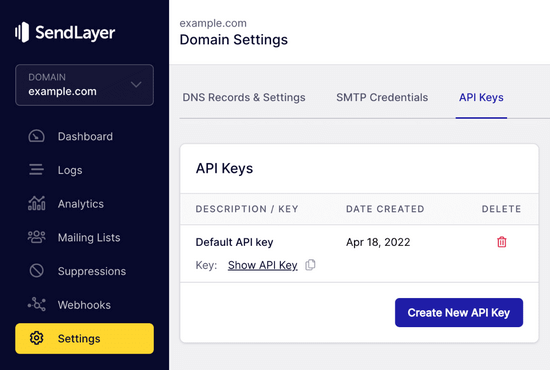
Sie können den API-Schlüssel von dieser Seite aus kopieren, indem Sie auf das Kopiersymbol klicken.
Etwa so:
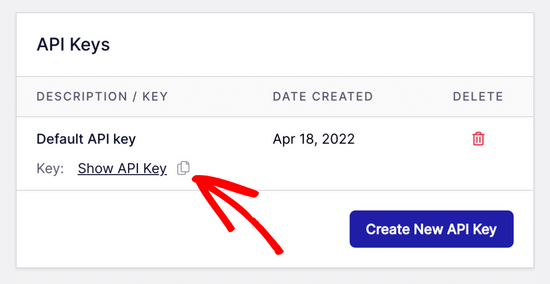
Danach können Sie zur Registerkarte des WP Mail SMTP-Einrichtungsassistenten zurückkehren.
Fügen Sie dann den API-Schlüssel an der entsprechenden Stelle ein.

Herzlichen Glückwunsch! Sie haben nun alles eingerichtet. Der letzte Schritt besteht darin, eine Test-E-Mail zu senden, um sicherzustellen, dass alles funktioniert.
Gehen Sie zu WP Mail SMTP “ Tools. Geben Sie auf der Registerkarte “E-Mail-Test” eine E-Mail-Adresse ein, an die Sie eine E-Mail senden möchten. Standardmäßig ist dies die E-Mail-Adresse des Administrators der Website. Klicken Sie auf “E-Mail senden”.
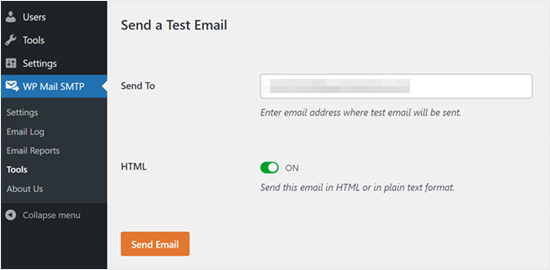
Sie sollten die Meldung ‘Test HTML email was sent successfully!
Überprüfen Sie Ihren Posteingang, um zu sehen, ob sie angekommen ist. Es sieht dann so aus:
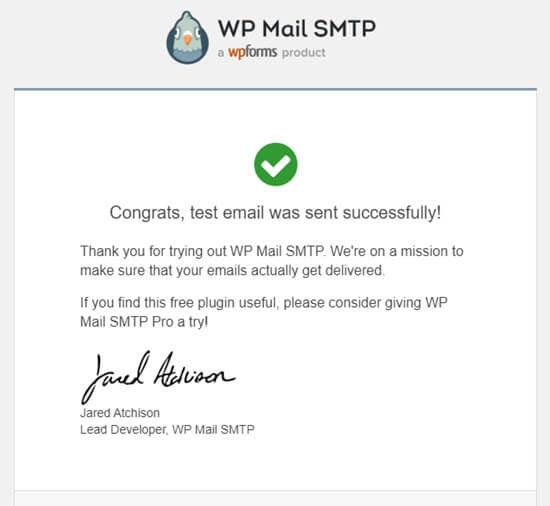
Hinweis: Wenn Ihr SendLayer-Konto noch nicht aktiviert ist, erhalten Sie die Meldung: [permission_denied]: E-Mail kann nicht gesendet werden. Ihr SMTP-Konto ist noch nicht aktiviert.
Alternative Wege zur Behebung des Problems, dass WordPress keine E-Mails sendet
Wie Sie aus der Liste der Mailer-Optionen des WP Mail SMTP-Plugins ersehen können, müssen Sie nicht unbedingt SendLayer verwenden. Es ist zwar unsere beste kostenlose Empfehlung, aber es gibt auch andere Optionen, die Sie verwenden können, einschließlich Microsoft 365, Gmail(Google Workspace), Amazon SES, etc.
Verwendung von Gmail oder Google Workspace mit WP Mail SMTP zur Korrektur von WordPress-E-Mails
Wenn Sie Gmail haben, können Sie dies zum Versenden Ihrer E-Mails verwenden. Wenn Sie das WP Mail SMTP-Plugin verwenden, müssen Sie Ihre E-Mail-Anmeldedaten nicht in WordPress eingeben.
Um Gmail oder Google Workspace zu verwenden, richten Sie WP Mail SMTP wie oben beschrieben ein und klicken dann auf die Option “Google / Gmail” für Ihren Mailer.
Als Nächstes können Sie die Mailer-Einstellungen konfigurieren, indem Sie die Ein-Klick-Einrichtung von WP Mail SMTP verwenden.
Bei dieser Methode müssen Sie keine eigene App erstellen, was viel einfacher ist. Sie müssen sich nur bei Ihrem Google Mail-Konto anmelden und auf “Einstellungen speichern” klicken.
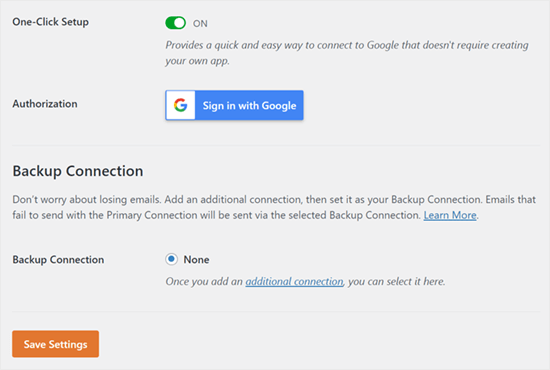
Die Verwendung von Google Mail oder Google Workspace für berufliche Zwecke birgt jedoch einige entscheidende Nachteile.
Zum einen müssen Sie sich möglicherweise an Ihren Webhoster wenden, damit er das richtige Zertifikat installiert, damit es funktioniert.
Ein weiterer Nachteil ist, dass Sie den gesamten Prozess erneut durchlaufen müssen, wenn Sie die E-Mail-Adresse in Zukunft ändern. Dazu gehört auch die Erstellung einer neuen Webanwendung.
Verwendung von Microsoft 365 mit WP Mail SMTP zur Korrektur von WordPress-E-Mails
Wenn Sie Microsoft Office 365 oder Outlook für Ihr reguläres E-Mail-Konto verwenden, können Sie auch dieses für den Versand von E-Mails über WordPress nutzen. Dies ist jedoch keine empfehlenswerte Option, da sie weniger sicher ist.
Sie müssen WP Mail SMTP wie oben beschrieben einrichten und dann bei der Auswahl Ihres SMTP-Mailers auf die Option “365 / Outlook” klicken. Anschließend müssen Sie eine App auf Microsoft Azure registrieren, damit Sie die unten stehenden Felder ausfüllen können.
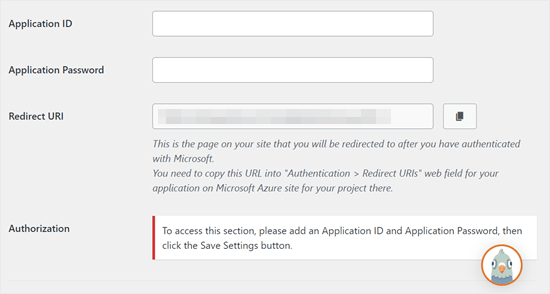
Weitere Einzelheiten finden Sie in der ausführlichen Anleitung zur Einrichtung von Outlook mit WP Mail SMTP.
Verwendung von Amazon SES mit WP Mail SMTP zur Korrektur von WordPress-E-Mails
Die Amazon AWS-Plattform verfügt über einen Simple Email Service (SES), den Sie verwenden können, um das WordPress-E-Mail-Problem zu beheben.
Das Beste an Amazon ist, dass Sie damit jeden Monat bis zu 62.000 E-Mails kostenlos versenden können. Der Nachteil ist, dass die Einrichtung für Anfänger etwas schwieriger ist, weshalb wir es nicht als unsere bevorzugte Option empfehlen.
Aber wie Sie sich vorstellen können, verwenden viele Fachleute und Experten Amazon SES für ihren WordPress-E-Mail-SMTP-Dienst, so dass wir keinen Artikel schreiben konnten, ohne es zu erwähnen.
Wenn Sie daran interessiert sind, Amazon SES mit WordPress einzurichten, lesen Sie die vollständige Anleitung zur Einrichtung von Amazon SES mit WordPress.
Für welchen Mailer Sie sich auch entscheiden, denken Sie immer daran, die Funktion “Test-E-Mail” zu verwenden, um sicherzustellen, dass die E-Mails erfolgreich versendet werden.
Sie müssen auch Ihren Posteingang überprüfen und bestätigen, dass Sie die Test-E-Mail erhalten haben.
Video-Anleitung
Wenn Sie visuelle Anleitungen bevorzugen, dann sehen Sie sich dieses Video an:
Haben Sie andere WordPress Fehler? Schauen Sie sich diese Leitfäden an
WordPress ist nicht perfekt, und von Zeit zu Zeit können Sie auf einige häufige Fehler stoßen. Hier sind einige Anleitungen, die Sie sich ansehen können, um sie zu lösen:
- Wie man den Add Media Button in WordPress repariert, der nicht funktioniert
- Wie man das Problem des Uploads von Bildern in WordPress behebt (Schritt für Schritt)
- Wie man den Fehler “Gemischter Inhalt” in WordPress behebt (Schritt für Schritt)
- WordPress-Beiträge mit dem Fehler 404 beheben (Schritt für Schritt)
- So beheben Sie den Fehler “WordPress-Datenbankfehler – Festplatte voll”
- So beheben Sie den Fehler beim Herstellen einer Datenbankverbindung in WordPress
- So beheben Sie den Fehler “Dieser Dateityp ist aus Sicherheitsgründen nicht zulässig” in WordPress
- So beheben Sie den 502 Bad Gateway Fehler in WordPress
- Wie behebt man, dass die WordPress-Suche nicht funktioniert?
- WordPress-Formular funktioniert nicht: 7 Tipps zur Problembehandlung
Wir hoffen, dass dieser Artikel Ihnen geholfen hat, das Problem, dass WordPress keine E-Mails sendet, zu beheben. Vielleicht interessiert Sie auch unsere Liste der häufigsten Probleme mit dem Block-Editor von WordPress oder unsere Auswahl der besten Plugins für die individuelle Anpassung von E-Mails in WooCommerce.
Wenn Ihnen dieser Artikel gefallen hat, dann abonnieren Sie bitte unseren YouTube-Kanal für WordPress-Videotutorials. Sie können uns auch auf Twitter und Facebook finden.





Will
My problem is that wordpress won’t send emails to or from an address that is coming from my domain name. E.g. @domain.com. But it will send from any other email address type.
Md Sajid
i successfully setup my site, and it is working very well.
thanks for this nice and working tutorial..
i used gmail api first method..
SORRY FOR MY BAD ENGLISH
idayat
hello, please does anyone know how can stop WordPress from sending automatic emails to blog subscribers, i want to use MailChimp but it seems i have to first disable WordPress. thank you
Lyndsay
Great instructions! Clear, easy to follow and they work!
Iman
Thank you so much. You have tutorial helped me fix my email problem . this was one of the best tutorials I have ever seen. every step is very well explained.
alex
Hi, I have installed SMTP – I think right.. but I’m still not receiving emails from the contact form. I’m also not getting new order notifications. can someone please help me?
Sagar Awal
check spam mail.
Nifemi
I’ve completed all the steps using mailgun but when I try to send a test email to my other webmails in that same domain, they never get delivered. However it works pretty well with other emails such as gmail.
Any idea about what might be causing this issue?
WPBeginner Support
Hi Nifemi,
Please contact Mailgun support they would be able to help you troubleshoot this.
Admin
Ron
Is there a way to find the emails that were sent and you did not receive because of this issue?
WPBeginner Support
Hi Ron,
Default WordPress notification emails are not stored in the database. However, if you are using a plugin which stores entries in the database then you may be able to see them.
Admin
Daniel Koo
Instead of the Success! message, I get an error like this:
——–
Not Acceptable!
An appropriate representation of the requested resource could not be found on this server. This error was generated by Mod_Security.
——-
What is the problem?
Colin
I’m having the exact same problem. The answer appears to lie in complicated CSS maneuvers that I hate.
Abhishek Kumar
Thank you so much for useful tutorials.
Anthony
Thank a lot. i followed your method 1 and it worked perfectly!
Michael Zorko
So…this used to be my go to app. Found a similar help video from you guys a while back. Loved Mailgun – then they started changing their policy. Now, it only works for verified email addresses..unless…you put a credit card on file.
Jack Hernandez
I’ve been having problems with admin and users (and new users) not receiving automatic notifications.
Will this also solve that issue?
Thanks
WPBeginner Support
Hi Jack,
Yes, it would. Missing notifications are almost always caused by email issues in WordPress.
Admin
Chloe
Hi,
I’m confused in the step of opening the cPanel in the hosting account. What is the hosting account? Is it found in WordPress? Thanks
WPBeginner Support
Hi Chloe,
Seems like you are using WordPress.com. Please see our guide on the difference between self hosted WordPress.org vs free WordPress.com blog.
Admin
Owen
I was having the exact same problem with e-mails not sending and these instructions were v useful. I have now fully resolved the issue – thank you very much
WPBeginner Support
Hi Owen,
We are glad you found the instructions helpful You may also want to subscribe to our YouTube Channel for WordPress video tutorials.
You may also want to subscribe to our YouTube Channel for WordPress video tutorials.
Admin
Amol
Hello,
Thank you for the topic. It helped me a lot and fixed the issue I was struggling with for last 3 days.
Regards,
Amol
Fred
I started to use the video guide and the first step was to set up a mailgun account. I created a password and clicked the verification link in my email to complete the account. However they then wanted to text me a confirmation code to a cell phone as a second verification. I only own a landline not a cell phone and there was no workaround so it is impossible for me to use mailgun. I realize most people these days have cell phones but it seems stupid they would not allow signup via computer (or via a voice code over the phone).
Fernán
Thank you so much! I just had some changes regarding domain settings, and this pointed me in the right way.
Pankaj Kumar
Hi, If i am using Zoho mail for example.com for email.
Can i still use mail1.example.com and configure mx record?
Will it work or stops my email account created on zoho mail for example.com
Melinda Thome
This worked perfectly, and solved all my WordPress email sending issues. Thank you!!
Melinda
Leo
My wordpress send emails, but, this emails Go to Spam folder… I need a soluction. I try using codes from functions.php but does not work. My solution was install Mail Bank plugin but, I dont want this plugin. I want a simple soluction.
casey
hello! I am having issues with my Contact page, we are not receiving new contact information in our CRM site. Can you please guide me to fix the issue?
Doron
Hey
Thanks for the great tutorial. I’m getting
“Mailgun HTTP API Test Failure; status “Free accounts are for test purposes only. Please upgrade or add the address to authorized recipients in Account Settings.”
Do you know why or how to resolve?
(Added an “authorized user” to my acount)
Alex Cramer
I’m having the same problem. I also don’t understand how to get to the cPanel. What am I missing?
Lawrence Ip
Ah! When in doubt add this TXT Record. @ v=spf1 include:_spf.google.com ~all
That is, this works for Namecheap (and most likely others) when Gmail is enabled. Enjoy!
Aaron Williams
I am having the problem that the wp_mail() function is not showing up in our functions.php document. If I read the documentation correctly, that means Gmail SMTP plugin still won’t work because it uses that function still. Every time I have tried to add the wp_mail() function it has resulted in a fatal error that kills the website and I have to remote into our server to delete the code to get the page working again. Any ideas?
WPBeginner Support
Hey Aaron,
wp_mail function resides in the core WordPress files, so you will not find it in your theme’s functions.php file. Since it is already part of the core, you do not need to add it. Try installing Gmail SMTP plugin, and it should work.
Admin
Clare
Hi there, so happy to have found this tutorial! Can anyone tell me if you need to use a subdomain to setup Mailgun? We have set this up using our root domain and are having some issues and I am wondering if this could be why. Any advice would be appreciated! Thanks, Clare.
Michael Halbrook
It can cause problems if you set it up with out one from what I’ve been reading, because if you set up the MX records for MailGun with your current e-mail address it can be problematic.
Michael Tillman
Great tutorial. I have to say the narrator has a really nice voice, nice and pleasant.
Eric
Using Mailgun worked like a charm. Thanks!
John F
will this fix conformation email not sending?
Callan
Hi,
I think I found an easy workaround for this problem. When setting up form fields, instead of using the generic email field I just use a different type of field and mark it as a “required” field. That way people will know that it is a required field and still provide you with a valid email address.
I have just had the same problem with all of a sudden WordPress not sending me mail from anyone who has a gmail address. I’ve changed the field types and am again receiving emails from submitted forms.
I’d be interested to see if anyone else would try to see if this works.
Steve
First off…very informative article…including the YouTube video on setting up the Google Apps for Work. So thank you for that!
A couple questions:
I use Mad Mimi for my email marketing…and they sent the below article out a while ago telling Gmail users to not use Gmail addresses for sending out Mad Mimi email campaigns (which is what I used to do), but instead to use a custom domain. So that’s what I did. I set up a custom “name@domain.com” address and have been using that. If I want to use the exact same “name@domain.com” address for the Google Apps for Work setup to receive notifications from my WordPress site…will this mess up stuff with the Mad Mimi emails?
Additionally, I currently have my personal Gmail setup to be able to send and receive email from the “name@domain.com” address…so how is that effected as well? Do I need to delete that stuff out of there if I go with this Google Apps for Work option to fix my issue with not receiving my WordPress notification emails?
Thank you so much in advance for any clarification on this.
Sacha Doucet
The article and video were super helpful! Thank you!!
WPBeginner Support
Hey Sacha,
Glad you found it useful. You may also want to subscribe to our YouTube Channel for more WordPress video tutorials.
Admin
Amy
Just wanted to say – thank you so much for this article! Has helped me fix my forms not sure what the issue was before, if it was the server or what – but the mailgun solution worked perfectly for me.
not sure what the issue was before, if it was the server or what – but the mailgun solution worked perfectly for me.
Akinola King
Thanks for this article.
David
Great article! Thank you for sharing!
1) Why does the mailgun HTTP API not require a username and password like the SMTP solution does? Is it because mailgun is verifying at the DNS level (with its SPF and domain key records) and with the API — so this setup removed the need for the SMTP credentials?
2) Am I correct that these sending issues (being rejected by Google or Yahoo’s mail servers) are mostly because people are trying to send email from their WP installations but are using a personalAccount@aol.com to send email from a WP install at example.com?
3) Would mailgun allow someone to send email as personalAccount@aol.com even though the mail is coming from the WP install at example.com
Thanks for your help!
Shaun Lawson
Thank you so much for these great instructions.
Worked for me first time.
Shaun
Lucas Shepherd
Postman SMTP fixed my wordpress email after trying everything everyone told me to try.
Doug
Thanks for pointing me to Postman SMTP. I too had tried several setups to no avail.
Jerry
Thanks Lucas, Me too!
Postman SMTP solved all my email woes.. I’ve been trying to test mail function on WordPress installed on localhost under Xampp for a day or two.
I’m brand new to WordPress and I’m learning that the secret to a happy life is getting the right Plugin.. recommendations are invaluable.
meenakshi
My cpanel is not showing Advanced DNS Zone edittor in Domain section . Wha shoud I do?
WPBeginner Support
You can try DNS Zone Editor or ask your hosting provider for help.
Admin
Mabel
I need help. I have successfully installed mailgun using your videio How to Fix WordPress Not Sending Email Issue, but my email notifications still do not send. Do I have to enter some code into each email template? I have no idea what I am doing.
bobby
You should really warn people about changing the mx records. It ruined my incoming mail for 5 hours and i had to change them back.
Bobby
I set this all up and never got an activation email from Mailgun. Pretty pathetic that an email smtp service can’t even figure out their own account activation system through….ugh….email.
I sent a support ticket in. Now, because I changed the settings on my hosting, NONE OF MY EMAIL IS WORKING. I have tried three different emails to activate the account, and none have gotten the activation email.
Luke Cavanagh
SendGrid is the best option now, the free plan covers up to 12,000 emails a month.
https://wordpress.org/plugins/sendgrid-email-delivery-simplified/
Marco Floriano
Amazing video, amazing tutorial. Nice solution. Perfect! Mailgun is amazing, thanks a ton guys!
Ademide
Thank you for tutorials. I couldn’t proceed because I was having the following error “Your account is temporarily disabled. Business Verification Please contact support to resolve”. I have raised two tickets already, it doesn’t seem to be helping. Any idea what I need to do to get this resolved?
WPBeginner Support
Mailgun has internal checks in place which may sometimes flag an innocent account as suspicious. You simply need to contact their support, they will ask you a few questions about your email usage and will unlock your account.
Admin
Wout
Oh man thank you so much for this! You’re lifesavers! Mails from my wp-site used to end up in Spam, now they reach the inbox with no problems… One thing worth mentioning may be that the domain you set up in Mailgun doesn’t show up in WP mails to users/customers, so you don’t have to use a matching domain for your site. You can setup mail1.example.com in Mailgun for your WordPress site anotherexample.com and it works.
WPBeginner Support
It works, but to ensure maximum delivery in the long run, it is recommended to use the same domain as your website.
Admin
Wout
Actually I still had some issues after testing, and decided to install sendgrid plugin, and that was easier to setup and works like a charm…
Lavish
My domain name is attached to Google Apps emails, I don’t want to mess up things. Can I instead use .org version of my domain name. I have .org and it is just parked (redirecting to .com) unused.
Thanks
Luke Cavanagh
Just make it easy and use SendGrid. You just create a general API and then add it into the settings of the SendGrid plugin on the site you need to use it on.
Michael Story
Hi you mention needing the shortcode for later in the video, where do you use the shortcode? Does it replace gravity forms?
Bill Frankell
Oh man, where were you last week with this? I spent four days of vacation working all this out on my own.
However I do not see my problem listed, which was using Yahoo mail.
Been a yahoo user since 2000 so hated to give way but finally set up new gmail accounts on all my websites which changed everything. I now have those accounts all forwarding to Yahoo, each with a note in the from address telling me their source.
There may have been a way to make Yahoo work, but I didn’t find it and finally gave up. This is a better setup because it lets me set up separate mailing lists and work with mail chimp and sumo me. So far in the last week we have collected over a hundred new members on one site, the difference is that now I get to see each one as it comes in, can delete my yahoo notice and still have the record on Gmail archives.
Having said all this, this page is being bookmarked for future reference. Thanks, it was almost timely.
amit
Sending WordPress Emails Using Gmail SMTP Servers. is it free feature
WPBeginner Support
There are both free and paid options. The free option is less reliable than the paid option.
Admin